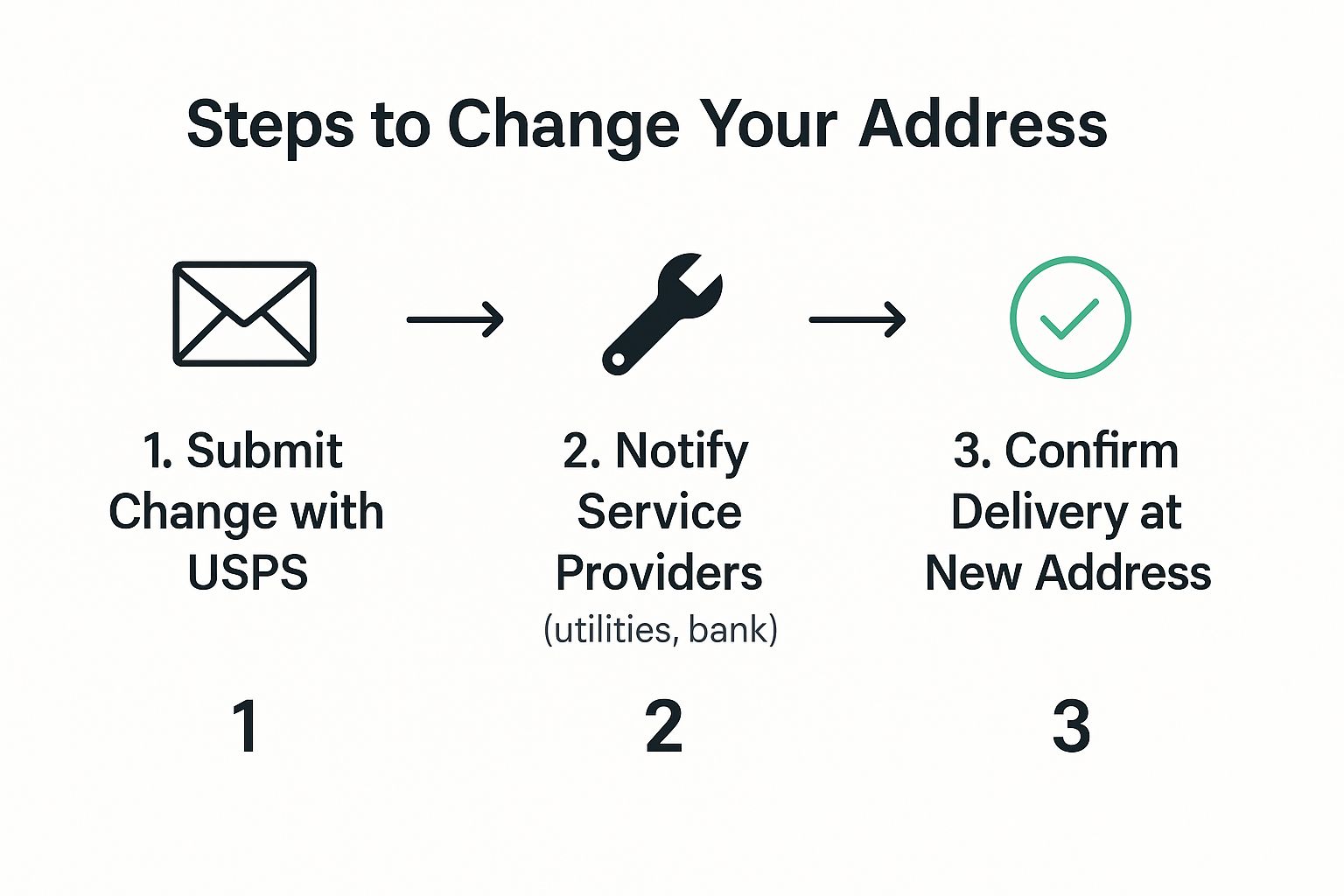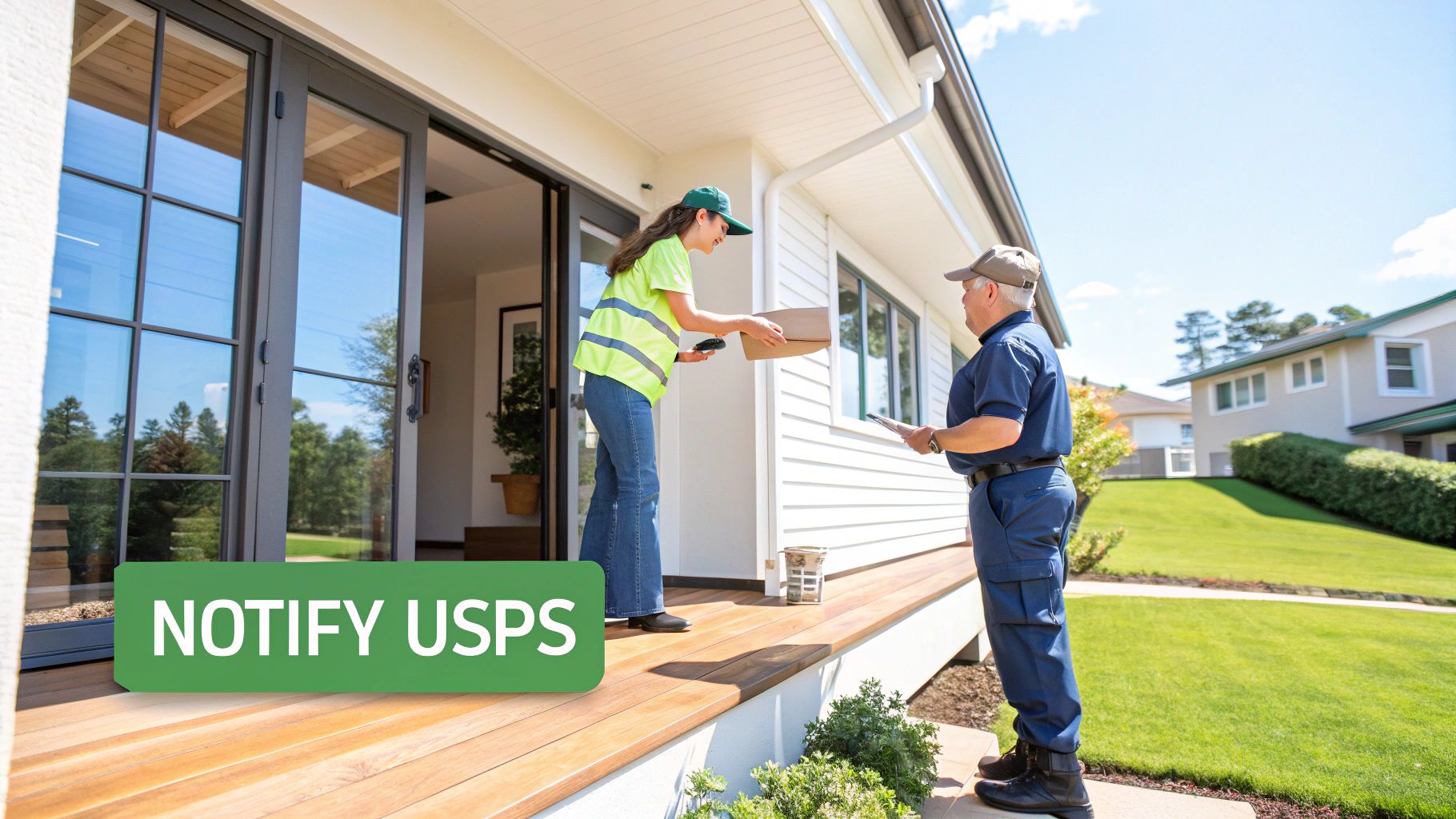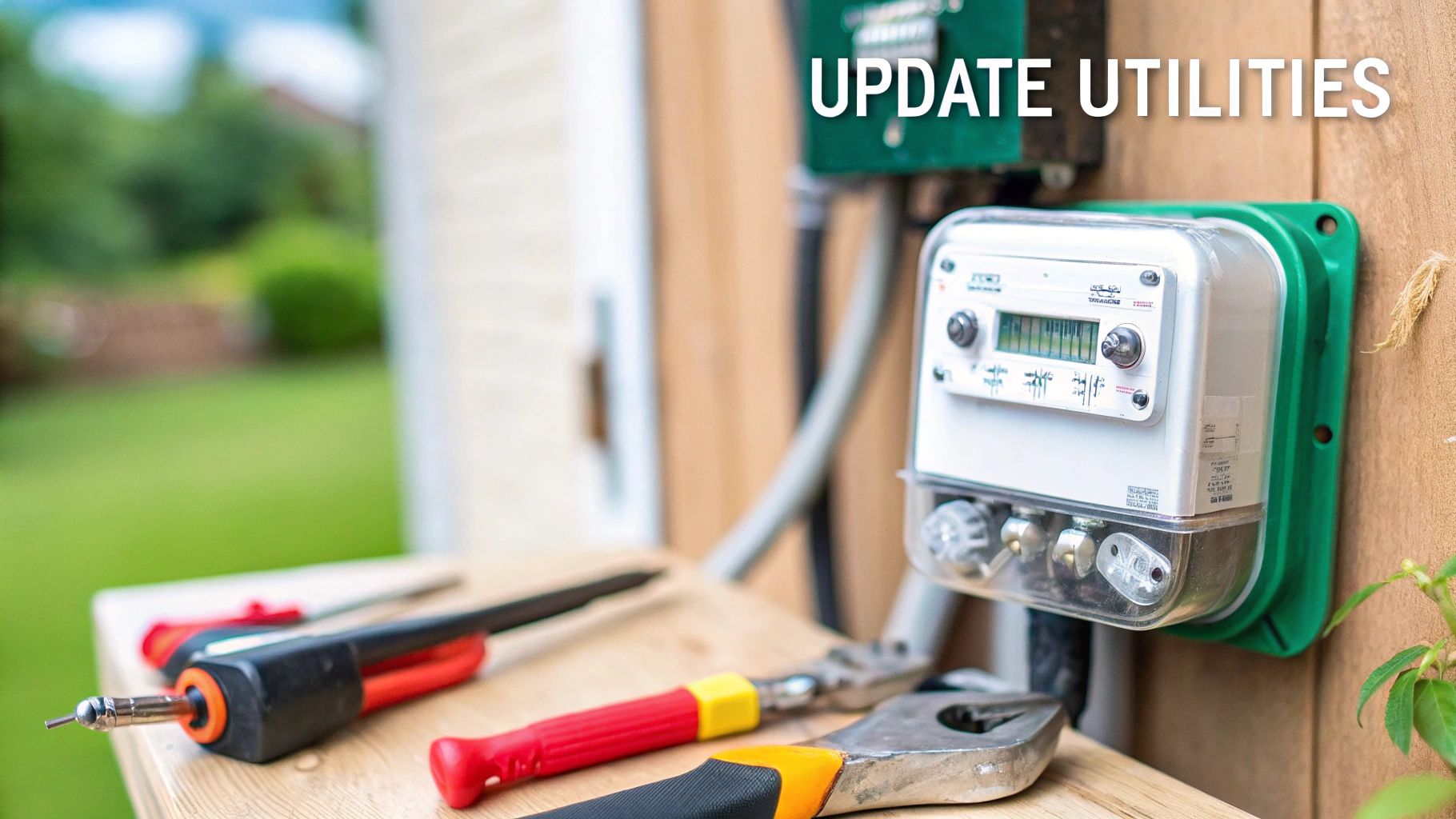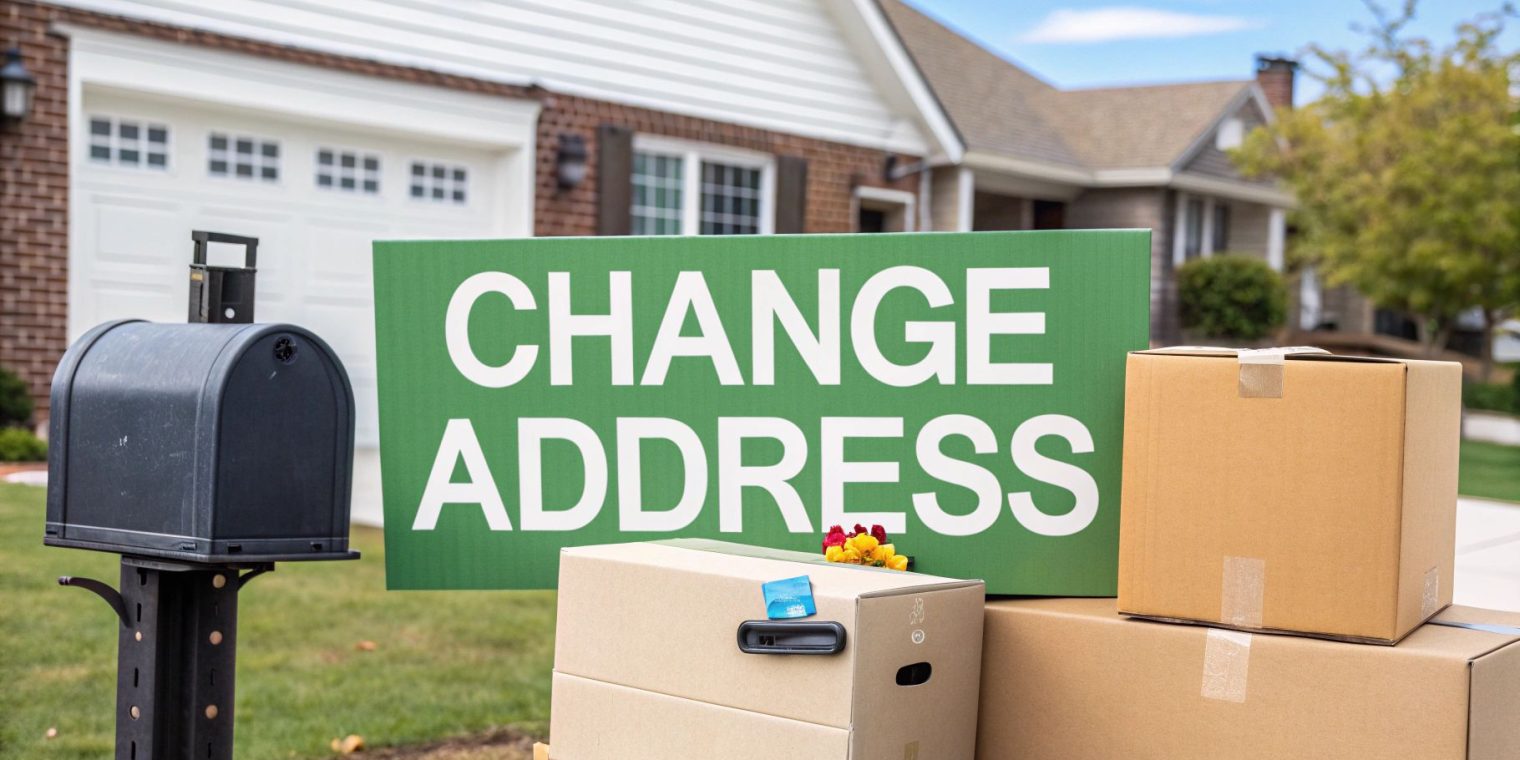When you're moving house, getting your address updated everywhere is one of those crucial jobs that can feel like a mountain to climb. The secret isn't just making a list; it's about tackling it in the right order. To make sure you don't miss a single bill or important document, you'll need to formally notify Australia Post, get in touch with all your service providers and financial institutions, and then double-check that everything is arriving at your new front door.
Your Essential Moving Address Change Checklist
Moving is a huge undertaking, but keeping track of who needs your new address doesn't have to be another source of stress. Think of this guide as your control centre for the entire process, giving you a clear path to follow. A bit of organisation here is what separates a smooth, hassle-free move from weeks of chasing lost mail and sorting out account mix-ups.
The whole task can seem overwhelming at first glance, but it really breaks down into a few manageable stages. This visual gives a great overview of the core steps involved.

As you can see, it's a logical flow: start with the official mail redirection, then work through your personal and financial accounts, and finally confirm everything is arriving correctly.
Prioritising Your Notifications
Let's be honest, some updates are far more urgent than others. Getting the most important ones sorted first—like Australia Post, your bank, and crucial government bodies like the ATO and electoral commission—is your best defence against major headaches.
Imagine missing a final electricity bill from your old place, only for it to escalate and impact your credit rating. Or picture your new bank card being delivered to your old address. These are the exact kinds of problems a little forward planning helps you sidestep completely.
If the list feels endless, just remember how common this process is. Data from the Australian Bureau of Statistics revealed that over 40% of Australians changed their address between 2019 and 2020 alone. People move for new jobs, better housing, and lifestyle changes all the time. You're walking a very well-trodden path.
A big mistake I see people make is relying solely on mail forwarding. It’s a fantastic safety net for the first few months, but it's temporary. The only way to guarantee your details are permanently updated is to contact each organisation yourself.
To make this manageable, I've put together a quick-reference table of the highest-priority contacts. This helps you focus on what truly matters first.
Priority Address Change Contacts
Here's a breakdown of the most critical organisations to notify, helping you prioritise your efforts during the busy moving period.
| Organisation/Service | When to Notify | Common Method |
|---|---|---|
| Australia Post | 1-2 weeks before moving | Online mail redirection service |
| Banks & Financial Institutions | 1 week before moving | Online banking portal or app |
| Australian Taxation Office (ATO) | As soon as you move | myGov account |
| Australian Electoral Commission (AEC) | As soon as you move | Online via the AEC website |
| Utilities (Gas, Electricity, Water) | 1-2 weeks before moving | Phone call or online account |
| Driver's Licence & Vehicle Rego | Within 14 days of moving | Online via state transport authority |
| Mobile & Internet Providers | 1-2 weeks before moving | Online account or phone call |
Getting these top-tier notifications out of the way early will lift a huge weight off your shoulders.
Using a checklist, whether it's on your phone or a notepad, is the best way to keep track of everything. Breaking the task down into smaller, themed groups (like 'Financial', 'Utilities', 'Subscriptions') makes it feel much less daunting. For more tips on getting organised, have a look at our complete guide on creating a checklist for a smooth transition into a new house.
This roadmap should give you the confidence to work through each notification methodically, ensuring nothing gets missed. The goal here is simple: to make your first week in your new home as calm as possible, with your mail and services arriving right where they should.
Updating Government Services and Official Bodies
Okay, let's talk about the serious stuff. Beyond sorting out your mail forwarding and Netflix account, there are some address changes that are non-negotiable—and legally required. Getting these official notifications done and dusted as soon as you move is crucial for everything from getting your benefits to fulfilling your civic duties and, importantly, avoiding fines. It’s a core part of any successful plan to change address when moving.
The best news? A lot of this can be handled in one place. If you're not already on myGov, now is the time to sign up. Seriously, creating an account and linking it to the main government services is a game-changer. Think of it as your single front door for updating multiple agencies at once, saving you a mountain of paperwork and time.

Core Federal Government Updates
First up, let’s tackle the big federal agencies. These are the ones every Australian resident needs to notify when they move, no exceptions.
Australian Electoral Commission (AEC): This one's a legal requirement. Keeping your enrolment up to date ensures you get all the right information for elections. If you don't, you could miss out on where to vote and even cop a fine for not voting. You can jump onto the AEC website and get it sorted in a few minutes.
Australian Taxation Office (ATO): The ATO needs to know where you are to send vital documents about your tax and super. An old address means you could miss notices, payment summaries, or other critical mail. This is one of the simplest to update through your linked myGov account.
Services Australia (Centrelink & Medicare): If you're receiving any Centrelink payments or are registered with Medicare, this is a must-do. Wrong details can mean delayed payments or missed health information. Just like the ATO, you can update both Centrelink and Medicare through your myGov portal.
I once spoke with a client who missed out on a significant tax refund for over a year simply because their details weren't updated with the ATO. The notice was sent to their old address and returned, leaving them completely unaware until they finally logged into myGov to check their super.
State-Specific Requirements You Cannot Ignore
Once the federal side is sorted, it's time to think local. Your state-level responsibilities are just as important, and they can vary depending on where you live.
The most common one is your driver's licence and vehicle registration. Most states and territories, like Western Australia, mandate that you notify the Department of Transport of your new address within 14 to 28 days of your move. This is a legal requirement, and you could face a fine if you're pulled over and your licence has an old address.
For instance, if you're moving from a rental in Joondalup to a new place in Rockingham, you’ll need to tell the WA Department of Transport. This makes sure your rego renewal and any traffic infringements go to the right house. Thankfully, you can usually do this online via your state's transport authority website, which is much better than waiting in line at a service centre.
Don't forget your local council, either. Your address impacts things like council rates, pet registration, and even your library membership. A quick browse of your new council’s website should tell you everything you need to know to get those details sorted.
Getting Your Mail and Deliveries Sorted

Making sure your letters and parcels find their way to your new place is one of the most critical parts of any move. The very first thing you should do when you change address when moving is to set up a mail redirection with Australia Post. Think of it as your safety net; it'll catch anything still being sent to your old address and forward it straight to your new home.
Getting it organised is simple and can be done online in just a few minutes. I always recommend setting it up at least a week before the moving trucks arrive to make sure it’s active from day one.
Arranging Your Mail Redirection
Australia Post gives you a few different redirection options, so you can pick what works for you. You can forward mail just for yourself, for everyone in your household, or even for a business. The service is available for 1, 3, 6, or 12 months.
So which one should you choose?
- 1-3 Months: This is a solid short-term fix. It’s perfect for catching those last-minute bills or letters you might have forgotten about in the chaos of packing.
- 6-12 Months: This is what I’d call the gold standard. It gives you a generous buffer to go through and manually update all your accounts without worrying about an important document going astray.
The fee is pretty reasonable, especially when you weigh it against the value of what could get lost – a birthday card with a gift voucher, a final notice from a utility company, or a crucial renewal document.
Here's a little trick I’ve picked up over the years: for the three months before you move, keep a running list on your phone. Every time a package arrives—whether it's from The Iconic, a new book from Amazon, or your monthly subscription box—add the store's name to your list. You'll end up with a perfect, personalised checklist for updating your details later.
Updating Your Online Shopping and Subscription Accounts
While mail redirection is a lifesaver, it’s not a forever solution. The real legwork involves methodically updating your address with every single online service and retailer you use. This is absolutely vital for making sure your packages arrive, as many couriers won't forward parcels to a new address.
This is especially important in a place like Australia, where new suburbs and homes are popping up all the time. Just to give you an idea, Australia's address count shot up by over 47,000 in a single quarter of 2025, bringing the national total to 15.7 million addresses. You can dive into more data on Australia's address landscape to see how this constant growth affects delivery networks.
Start by logging into your accounts with the big players: major online stores, food delivery apps, and any services you subscribe to. A classic mistake I see people make is updating their main account profile but then forgetting to change the default shipping address at checkout. Always, always double-check your shipping info before you hit that final "buy" button after you've moved. It’s a tiny step that saves a massive headache.
Getting Your Utilities and Home Services Sorted
Let's be honest, sorting out your utilities is one of the most critical parts of any move. You don't want to be left in the dark on your first night, nor do you want to keep paying for power at your old place. Getting this right means orchestrating a careful switch-over: disconnecting the old and firing up the new.
It’s more than just electricity and gas. We’re talking water, and of course, the internet – which, for most of us, is just as essential as running water these days. The key is giving your providers enough notice.
I always recommend contacting all your utility providers at least two weeks before your moving date. This heads-off any last-minute panic and gives them plenty of time to schedule everything. Trust me, there’s nothing worse than finishing a gruelling day of moving boxes only to realise you have no hot water or Wi-Fi. A few phone calls two weeks out can save you a world of pain.
Nailing the Utility Connection Timeline
The dream is a seamless transition. Power goes off at your old place the day you hand over the keys, and it’s ready and waiting at the new place the moment you walk in. Thankfully, most energy retailers are pretty skilled at this and can usually handle the disconnection and new connection in a single conversation.
Here’s a timeline I’ve found works well:
Two Weeks Out: This is the time to call your electricity and gas providers. Give them your move-out date for the old property and your move-in date for the new one. This is also a fantastic opportunity to see if you can get a better deal. Your new home’s location or energy needs might open you up to more competitive plans, so it pays to shop around.
One Week Out: Time to tackle the internet. Whether it's NBN or another service, this connection often has the longest lead time, particularly if you need a technician to come out. It’s also a good moment to research the best service for your new address and compare things like 5G home internet vs. fiber options.
The Day Before the Move: Make a quick round of confirmation calls. A five-minute chat with each provider to confirm everything is set for the switchover gives you incredible peace of mind and nips any potential mix-ups in the bud.
Don't Forget These Other Household Services
While you're focused on power and internet, it's easy to let other regular services slip through the cracks. Forgetting these can lead to surprise bills and frustrating gaps in service down the line.
Do you have a monitored home security system? You’ll need to let your provider know you're moving so they can either transfer the service or cancel it. The same goes for any recurring contracts like pest control or pool maintenance. A good tip is to scroll through your bank statements for any recurring debits – it’s a great way to jog your memory.
A big one people often forget is the local council. You absolutely need to notify them. This ensures you start receiving the rates notice for your new property and, just as importantly, stop being billed for the old one. This is also how you'll update your pet’s registration details to stay compliant with local rules.
One final pro tip: if you can access the meters at your old property on your last day, take a photo of the final readings with your phone. It’s the best way to guarantee your final bill is spot-on and you aren’t paying for the new occupant’s energy use.
Letting Your Financial and Insurance Providers Know You've Moved

When you're caught up in the whirlwind of moving, it's easy to overlook the admin side of things. But when you change address when moving, sorting out your finances and insurance is every bit as crucial as redirecting your mail. An old address lingering on your bank or insurance files can cause real headaches, from missed statements and surprise late fees to the frightening risk of fraud if your personal documents end up in the wrong letterbox.
Thankfully, most banks and financial institutions have made this a pretty painless task. You can usually jump onto their online banking portal or use their mobile app to get your details updated in just a few clicks. It’s a small job that saves a lot of potential trouble down the track.
Your Financial Contact List: More Than Just Your Bank
It’s worth taking a moment to think about all the financial services you use. It's often more than just your main bank account. I always recommend making a dedicated checklist just for this part of the move.
Be sure to get in touch with:
- Banks and Credit Unions: This covers all your transaction, savings, and loan accounts.
- Credit Card Companies: Don't forget any store cards you might have.
- Superannuation Funds: You need those annual statements and other important fund updates.
- Investment Platforms: Or, if you have one, your personal financial advisor.
- Buy Now, Pay Later Services: Think Afterpay, Zip Pay, and similar platforms.
Ticking these off isn't just about being organised. It's a fundamental step in protecting your identity and keeping your credit history in good shape.
Don't Forget Your Insurance Policies
This one is a biggie. Your insurance policies are priced and structured based on your address, so failing to update them isn't just an oversight—it could be a costly mistake. An out-of-date address can have serious repercussions, and in a worst-case scenario, could even void a claim.
Think about it this way: a nasty hailstorm damages your car, which is now parked at your new place. If your insurer thinks you still live in a different suburb with a lower risk profile, they could argue that the policy doesn't cover the vehicle's new location. The same principle applies directly to your home and contents insurance. It's simply not a risk worth taking. For a more detailed look at this, our guide on essential insurance tips for a stress-free move is a great resource.
My best advice is to call your insurers before you move. Your home and contents premium, for instance, is calculated for your specific property. That means your premium might go up or down, and it's vital to have the right cover in place from the very first day you get the keys.
The precision of location data used by businesses is getting sharper all the time. In the Australian Capital Territory, for example, an incredible 99.52% of addresses were geocoded right down to the specific property level as of May 2025. This shows just how accurately insurers and others can now assess risk based on location. You can read more about the precision of address data in the ACT.
Make sure these are on your call list:
- Home and Contents Insurance
- Car Insurance
- Health Insurance
- Life Insurance
A quick call or online update ensures your protection continues without a hitch, giving you peace of mind that your most important assets are covered.
Finalizing Personal and Professional Contacts
With the official mail rerouted and the utilities sorted, it's time to tackle the final piece of the puzzle: letting your personal and professional networks know you've moved. This last sweep is all about maintaining continuity in your everyday life, making sure you don’t lose touch with the people and services that matter most.
First up, let’s talk work. Your employer absolutely needs your new address for payroll, tax documents like your annual payment summary, and all sorts of other HR records. A quick email to both your manager and the HR department is usually all it takes. It's a simple step that prevents any headaches with your pay or important documents getting lost in the mail.
Updating Schools and Care Providers
If you have kids, their school or childcare centre should be one of your first calls. It's crucial they have the right address on file, not just for report cards but, more importantly, for emergency contact information. You want them to be able to reach you without a moment's delay.
The same goes for your family's health. Think about your regular GP, dentist, and optometrist—they all need your updated details. This ensures you'll continue to receive appointment reminders and other important health correspondence. And don't forget your furry family members! Your vet needs the new address to keep their microchip details and vaccination records current.
Here's a handy tip from experience: Before you move, give your main healthcare providers a call and ask if they can recommend a practice in your new suburb. A trusted referral can save you a world of effort trying to find a new doctor or dentist from scratch after you've unpacked.
Handling Memberships and Personal Connections
Now for the final round-up. Go through a mental checklist of all your memberships and personal subscriptions. This includes places like:
- Your local gym or fitness studio
- The library
- Any social or sporting clubs
- Store loyalty programs (so you don't miss out on those points!)
Updating these ensures you won’t miss renewal notices or special communications.
Last but not least, tell your friends and family! While your closest circle will likely know already, a simple and stylish e-card or a private message in a group chat is a great way to inform everyone else. It’s a lovely personal touch that officially closes the chapter on your move, ensuring your new house quickly feels like home as cards and visitors start arriving at the right doorstep.
Got Questions About Changing Your Address? We've Got Answers
Even with the best checklist in hand, the nitty-gritty of a house move can still throw a few curveballs. It's perfectly natural to feel a bit swamped by the details, but trust me, getting a few key questions answered can make a world of difference. After years in this business, I’ve noticed the same queries pop up time and time again.
"Do I Really Need Mail Redirection?"
This is probably the number one question I hear. People think if they’re diligent about updating their address everywhere, they can skip it. My honest advice? Don’t. Think of mail redirection from Australia Post as your safety net.
No matter how organised you are, it’s almost guaranteed something will slip through the cracks—an old loyalty card, a forgotten subscription, or a yearly statement from an account you barely use. A redirection service, which can last for up to 12 months, ensures these stragglers find their way to your new letterbox.
"When's the Right Time to Start?"
Timing is everything, and it’s a common point of confusion. You don't want to start too early, but leaving it too late creates unnecessary stress.
My Two-Cents: I always tell people to aim for the two-week mark before moving day. This is the sweet spot for notifying the big players like your utility companies and setting up that mail redirection. For the less critical stuff like magazine subscriptions or store loyalty programs, you can chip away at those during the first month in your new home.
"What If It's Only a Temporary Move?"
What if you're not moving for good? Maybe it’s a six-month work contract interstate or a short-term rental while you renovate. You still need to be on top of your admin.
A mail redirection is non-negotiable here; set it up for the exact duration of your temporary stay. I’d also strongly suggest updating your address for the absolute essentials like your bank and the Australian Taxation Office (ATO). You simply can't risk missing their correspondence. It's easy enough to switch it all back once you return.
"Is There an Easier Way to Do All This?"
Ah, the dream of a single button to update everything! While that doesn't quite exist, your myGov account comes incredibly close. It’s a huge time-saver, letting you update your details with the ATO, Medicare, and Centrelink all in one place.
For a deeper look into other common head-scratchers, it's worth reading these top questions about moving house answered by experts.
Ready to make your move completely stress-free? Let the experts at Emmanuel Transport handle the heavy lifting. We offer a friendly, reliable removalist service across Perth, from packing to final placement, ensuring your belongings are treated with the utmost care. Get your free, transparent quote today at https://emmanueltransport.net.au.













